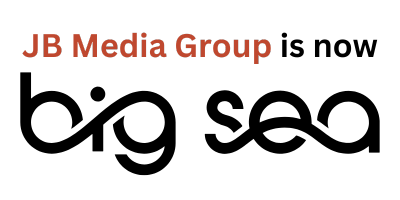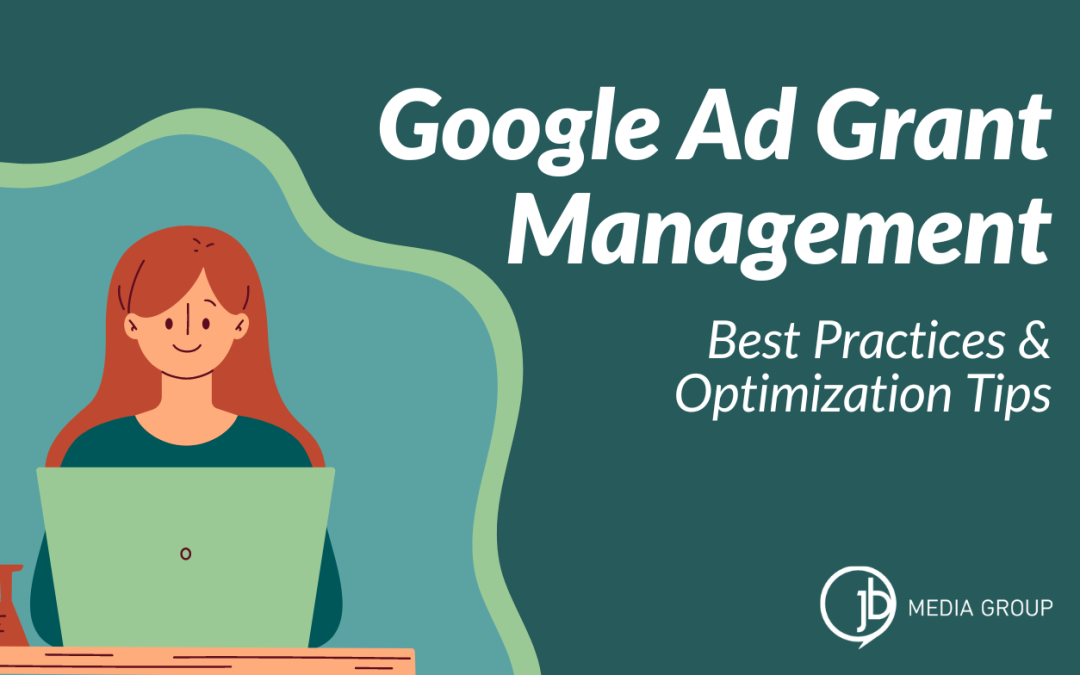Navigating the digital marketing landscape is as crucial for nonprofits as corporations—perhaps even more so. With limited resources, nonprofits need to stay on top of the latest tools and trends that can amplify their messages and impact. One such tool in the digital arsenal is Google Ad Grants, a program offering nonprofits free, in-kind advertising on the Google platform.
However, the success of this grant hinges on a strategic understanding of Google Ads and Google Ad Grant management best practices for effectively leveraging these funds.
>> If you think you qualify but need help navigating the process—or if you already have a Google Ad Grants account but aren’t sure if your nonprofit is getting the most out of it—JB Media is here to help with all your Ad Grants Management needs. Get expert help today!
The Impact of Google Ad Grants on Nonprofits
In a world where the attention of most people is captured by screens and the Google search engine is king for finding information, the Google Ad Grants program for nonprofits offers an unparalleled opportunity.
The grant provides up to $10,000 worth of in-kind monthly advertising to eligible nonprofit organizations to increase their reach, drive website traffic, and ultimately drive cause-driven awareness or call-to-action responses. The benefit goes beyond the pricing and monetary value, elevating nonprofits’ voices, aiding in resource mobilization, and building community.
Yet, for many nonprofits, the world of digital advertising can seem daunting and complex. Without a solid management strategy, the potential of Google Ad Grants often remains unrealized.
Applying for the Google Ad Grant: A Step-by-Step Guide
Understanding the eligibility requirements and the application process is always your first step.
Eligibility and Requirements
To be eligible for the Google Ad Grants program, nonprofits must hold valid charity status and meet Google requirements regarding website content and several other stipulations. These include maintaining a robust web presence, adhering to nondiscriminatory practices, and publishing substantial content on their primary website.
There are also requirements regarding the type of nonprofit, and some organizations, such as schools, educational institutions, healthcare groups, and governmental entities, are not eligible.
>> Learn more about eligibility and requirements here.
Application Process
The application process involves several steps, from signing up for a Google for Nonprofits account to registering for an AdWords account, submitting the AdWords pre-qualification form, and monitoring the inbox for a decision. The key is demonstrating that your organization aligns with Google’s standards and that you’re ready to manage the grant effectively once approved.
Once approved, it’s time to create a solid Google Ad Grant management strategy.
>> Learn the latest on the application process and verification here.
Best Practices for Setting Up and Managing Google Ad Campaigns
Every aspect of Google Ad Grants campaigns presents an opportunity for effective management or missed potential. Here are the best practices for maximizing your Google Ad Grants.
Daily Budget Management
What is the daily budget for a Google Ad Grant? The grant offers up to $329 per day in in-kind advertising, which can make every penny count. Setting campaign budgets that maximize the daily grant ensures steady campaign activity while balancing the funds across your campaigns. If you set a budget for any campaign or across all campaigns over the maximum daily Google Grant budget, then your account will pause for the day once you reach the full Google Ad Grant utilization.
For campaigns that regularly use the total budget, we recommend the following optimizations to ensure the best and most strategically efficient use of funds:
- Fine-tune the target keywords to focus on the most relevant, engaging, and highest-converting topics
- Add negative keywords to help weed out irrelevant traffic
- Explore bidding strategies that focus on maximizing conversions
- Adjust the daily budget between campaigns to ensure the most important and highest converting campaigns are getting their fair share of the budget
- Add a daily ad schedule to limit the ads to run when your target audience is online
Optimizing Landing Pages
The specific pages you direct your new web traffic often determine the success of your Google Ad Grant campaigns. Landing page optimization is essential for user experience and calls-to-action specific to your nonprofit goals; these pages convert clicks into engaged community members, program participants, and future donors. Whether it’s a donation page, homepage, program registration, volunteer sign-up, fundraising page, or subscription to your newsletters, always point your ads to pages that encourage conversations and further the user’s engagement with your cause.
Placing Limits on Campaigns and Ad Groups
Do you place limits on campaigns, ad groups, or ads? Setting clear limits on campaigns, ads, or ad groups ensures your efforts are targeted and measurable. It also prevents funds from being spread too thin over underperforming ads or related keywords, which could lead to rapid use of your daily budget without optimal results.
Ensuring Compliance for Long-term Eligibility
To maintain eligibility, regular double-checks for compliance are necessary. Google Ad Grants policies can change; staying informed and updated is crucial. Conduct internal audits to ensure the ads and campaigns comply with the current policies and regularly review the performance criteria set by Google.
Granular Geographic Targeting
Local SEO strategies can be compelling for nonprofits. By targeting your ads to specific geographic locations, you ensure they reach audiences relevant to your cause and capable of participating in your organization’s activities. This focus increases the value of your ad spend by reaching those most likely to respond.
Optimization Tips for Maximizing Ad Performance
Next comes the fine-tuning. With these tips, you can enhance your Google Ad campaigns’ immediate and long-term performance.
Keyword Research and Strategy
Keywords are the bridge between user intent and your ad. Research to discover which keywords and search terms are relevant to your cause, have high search volumes, and are less competitive to make the most of your ad placement. A mix of broad and long-tail keywords can help capture different sales funnel levels, from awareness to donation or other conversions.
Over time, it is important to finetune your keyword strategy to focus on the keywords that send the most engaged users (those that spend the most time on your site) and those that drive the most conversions to your tracked calls to action. If you have keywords that are sending a lot of traffic and using up a lot of your budget but that traffic is bouncing at a high rate (meaning that they only look at one page before leaving your website), it is important to remove or reduce the bid, or reduce campaign budgets to limit funds going to underperforming keywords.
Measuring and Adjusting for Success
Google Analytics (GA4) is a potent tool for measuring success. Metrics like click-through rates (CTRs), conversions, and quality scores can signal where adjustments need to be made. Use these insights to refine your campaigns for better performance over time continually.
Tracking Conversions Effectively
It’s essential to set up conversion tracking to understand the impact of your search ads. Tracking donations, program leads, registrations, event sign-ups, or newsletter sign-ups will provide clear visibility into the effectiveness of your ads and help measure return on investment.
Adding conversion tracking also unlocks a more advanced bidding strategy called Optimize for Conversions, which is only available for campaigns that actively track relevant conversions. This helps your campaigns maximize conversions first and foremost.
Real-world Examples of Successful Google Ad Grant Campaigns
At JB Media, we’ve seen firsthand the transformation that well-managed Google Ad Grants campaigns can bring to nonprofits. Our experience highlights the grant’s power when managed effectively.
>> Check out our success stories here.
10 Secrets to Google Ad Grants Success
We often hear various reasons for the Google Ad Grants program not working for nonprofits. We have helped many organizations that struggle with this to find traction and unlock high-quality, sustainable success with this free advertising program.
Over the years, we have uncovered 10 essential tactics, differentiating highly effective Google Ad Grants campaigns from unsuccessful ones.
>> Visit our 10 Secrets to Google Ad Grants Success page to see our 45-minute training webinar and to read our detailed guide.
The Google Ad Grants program presents a massive opportunity for nonprofits to promote their work and make a meaningful impact on the communities they serve. Leveraging this free advertising with strategic management practices can increase online presence, website traffic, and—most importantly—engagement with your cause.
Maximizing the Google Ad Grant’s potential can be complex and requires a deep understanding of digital marketing. Following the best practices outlined here, nonprofits can establish a strong foundation, optimize their campaigns, and drive sustained success through online advertising. With a commitment to continuous monitoring and optimization, the Google Ad Grants program can be a game-changer in nonprofit digital marketing strategies.
To further amplify your nonprofit’s message and reach, consider how JB Media Group can help manage and optimize your Google Ad Grants strategy and campaigns. Our expertise in nonprofit marketing ensures that the value of Google Ad Grants is realized to its fullest potential. Contact us and start making a difference in the digital realm today!
Take the first step toward securing your Google Ad Grants account today, and position your organization to drive impactful change well into the digital future. Contact us to get started with Google Ad Grants management.



